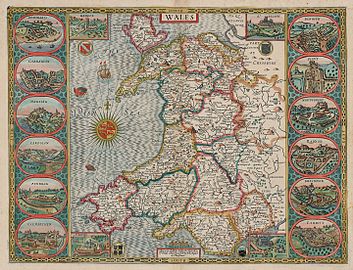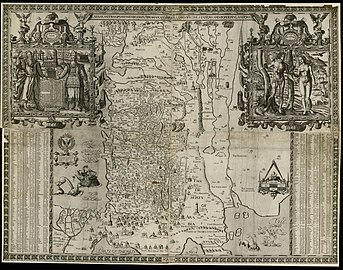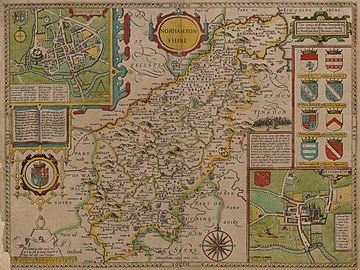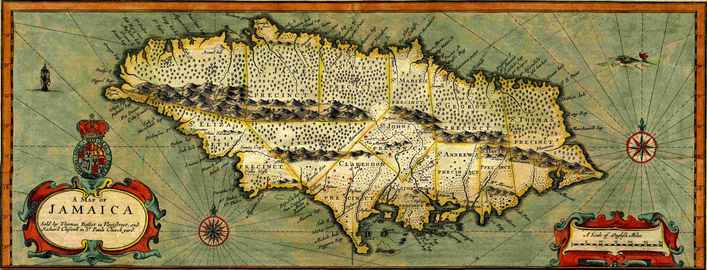John Speed
This article needs additional citations for verification. (November 2011) |
John Speed | |
|---|---|
 Memorial to John Speed, St Giles-without-Cripplegate | |
| Born | 1552 Farndon, Cheshire |
| Died | 1629 (aged 76–77) St Giles-without-Cripplegate, Cripplegate, London |
| Nationality | English |
| Scientific career | |
| Fields | Cartography, history |
John Speed (1552 – 28 July 1629)[1] was an English cartographer and historian. He is known as England's most famous Stuart period mapmaker.[2][n 1]
Life
Speed was born at Farndon, Cheshire, and went into his father's tailoring business.[4] While working in London, his knowledge of history led him into learned circles and he came to the attention of Sir Fulke Greville, who subsequently made him an allowance to enable him to devote his whole attention to research. As a reward for his earlier efforts, Queen Elizabeth granted Speed the use of a room in the Custom House.
He is buried with his wife in St Giles-without-Cripplegate church, Fore Street within the Barbican Estate in the City of London.[5][6] A memorial to John Speed was also erected behind the altar of the church. According to the church's website, "[His was] one of the few memorials [in the church] that survived the bombing" of London during The Blitz of 1940–1941 ... The website also notes that "[t]he cast for the niche in which the bust is placed was provided by the Merchant Taylors' Company, of which John Speed was a member." His memorial brass has ended up on display in the Burrell Collection near Glasgow.
Works
It was with the encouragement of William Camden that Speed began his Historie of Great Britaine, which was published in 1611.[7] Although he probably had access to historical sources that are now lost to us (he certainly used the work of Saxton and Norden), his work as a historian is considered mediocre and secondary in importance to his map-making, of which his most important contribution is probably his town plans, many of which provide the first visual record of the British towns they depict.

His atlas The Theatre of the Empire of Great Britaine was published in 1610/11, and contained the first set of individual county maps of England and Wales besides maps of Ireland [five in all] and a general map of Scotland. Most, but not all, of the county maps have town plans on them; those showing a Scale of Passes being the places he had mapped himself. In 1627, two years before his death, Speed published Prospect of the Most Famous Parts of the World which was the first world atlas produced by an Englishman. There is a fascinating text describing the areas shown on the back of the maps in English, although a rare edition of 1616 of the British maps has a Latin text – this is believed to have been produced for the Continental market. Much of the engraving was done in Amsterdam at the workshop of Jodocus Hondius. His maps of English counties are often found framed in homes throughout the United Kingdom.
In 1611, he also published The genealogies recorded in the Sacred Scriptures according to euery family and tribe with the line of Our Sauior Jesus Christ obserued from Adam to the Blessed Virgin Mary, a biblical genealogy, reprinted several times during the 17th century.
Maps
-
Speed's 1610 map of Wales
-
An example of an insert from Speeds 1610 map of Wales
-
The Countie Pallatine of Lancaster described and divided into hundreds, 1610
-
Wilshire, 1610 with a townplan of Salisbury and a view of Stonehenge
-
Northamptonshire, 1610
-
A New Mape of Ye XVII Provinces, 1626 (The Netherlands)
-
The Kingdome of China, 1626
-
A New And Accvrat Map of the World, 1646 miniature edition
-
Jamaica, 1676
Town inserts
-
Bedforde, 1611
-
Dubline, 1610; an 1896 reprint
-
Monmouth, 1610
-
Oxford, 1610
-
Redding, 1610
-
Bangor, 1610
-
Brecon, 1610
-
Cardiff, 1610
-
Montgomery, 1610
-
St David's ,1610
Footnotes
- Notes
- ^ Major-General William Roy, co-founder of the Ordnance Survey and earlier Christopher Saxton also contend for the most famous status. The word cartography refers to the 'drawing of the charts of maps' and derives from the French carte, card or chart, and Greek graphia, writing. Although it is a useful term ... it is important to note that the word was only coined around 1859 and therefore was not used by the Ordnance Survey's earliest writers and readers.[3]
- References
- ^ Baynton-Williams, Ashley. "John Speed". MapForum.Com. Retrieved 17 September 2012.
- ^ "Maps by John Speed". Jonathan Potter Limited. Archived from the original on 3 March 2012. Retrieved 17 September 2012.
{{cite web}}: Unknown parameter|deadurl=ignored (|url-status=suggested) (help) - ^ Hewitt, Rachel (2010). Map of a Nation. London: Granta Publications. pp. xxvi. ISBN 978-1-84708-254-1.
- ^ "The Life of John Speed". JohnSpeedMaps.co.uk. Retrieved 17 September 2012.
- ^ "Heritage". St Giles' without Cripplegate. Retrieved 17 September 2012.
- ^ Hibbert, Christopher; Ben Weinreb; John Keay; Julia Keay. (2010). The London Encyclopaedia. London: Pan Macmillan. p. 762. ISBN 978-0-230-73878-2.
{{cite book}}: CS1 maint: multiple names: authors list (link) - ^ . Dictionary of National Biography. London: Smith, Elder & Co. 1885–1900.
- ^ "Biography John Speed II". MapForum.com. 3. 2006.
Further reading
- Johan Speed, Nigel Nicolson (introduction), The Counties of Britain: A Tudor Atlas, Thames & Hudson (1989): ISBN 0-500-25104-5; Pavilion Books (1992): ISBN 1-85145-131-5 (pbk, 1995): ISBN 1-85793-612-4
External links
- 1542 births
- 1629 deaths
- English cartographers
- 16th-century cartographers
- 17th-century cartographers
- People of the Tudor period
- Burials at St Giles-without-Cripplegate
- People from Cheshire
- 16th-century English writers
- English historians
- 16th-century historians
- 17th-century historians
- 17th-century English writers
- English male writers




















